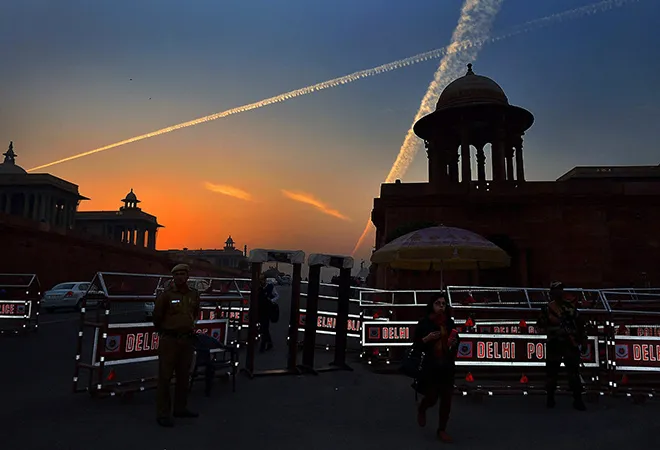-
CENTRES
Progammes & Centres
Location
The singular character of Delhi needs recognition. The first fact is that in essence Delhi is a city. It is also the national capital and the centre of the most critical national decision-making.

Image Source: PTI
The tumultuous mid-night incident at the Delhi Chief Minister’s residence involving the Delhi Chief Secretary triggered a governance crisis in the national capital. The situation gave full occasion to political parties to sumptuously feast on a diet of vilification against each other. As is commonplace, when politics descends into a slanging match, the narrative of each side becomes economical with the truth. The sole objective then is to badmouth the opposition and create an image of righteousness for oneself. In such a free-for-all, public cause, very sadly, is the casualty. This is precisely the outcome that was recently witnessed in Delhi. Unfortunately, in the multitude of screeching voices, the deep institutional flaws that cast a dark shadow on the governance of Delhi received scant attention.
Delhi’s governance architecture may appear to many as an enigma wrapped in a mystery. The reality is that too many threads of governance have got intertwined in a jungle of fibres that defy unraveling and suffocate delivery of services. There is an entire gamut of historical events and political rivalries that have culminated in the present situation. But Delhi’s governance is the core issue viewed by this article in the light of the principles of good governance and national security.
Till 1992, except for a brief interlude, Delhi was a union territory under the complete control of the Government of India. While local political leaders continued to agitate for Delhi’s statehood, others, including Ambedkar and Nehru, were not convinced about the wisdom of the entreaty. From the beginning to the present day, starting from the founding fathers, yesteryear’s national political leaders to national leaders of today and the two major national political parties — there has been skepticism about handing over the country’s capital to any government other than the central. At the top of their apprehensions, one thought was common — Delhi is the national capital. However, following decades of local advocacy for Delhi to acquire the status of a State, Delhi was grudgingly allowed its ‘statehood’ early in the 1990s, with a Chief Minister and a popularly elected unicameral legislature. Even so, the ‘State’ remained truncated in its powers. It remained in substance a union territory and in form a State, with the Lt. Governor retained as its chief executive.
"Till 1992, except for a brief interlude, Delhi was a union territory under the complete control of the Government of India. While local political leaders continued to agitate for Delhi’s statehood, others, including Ambedkar and Nehru, were not convinced about the wisdom of the entreaty."
What the ‘statehood’ did was that it made the already complicated governance of Delhi more confounded. With a Lt. Governor, several municipal corporations and scores of parastatals that had already carved out amongst themselves functions that the city had to perform, the Chief Minister and his Cabinet made a late entry and began jostling for what they considered their rightful space. They were backed by the strength of the popular vote. Delhi, as a consequence, landed in a situation where a city had many departments of the Centre, several departments of the State, scores of parastatals and five ULBs (urban local bodies) providing bits of governance. It could safely be asserted that Delhi has more government and less governance than any other city or state in the country. The question, therefore, that begs an answer is how things can be simplified so that good governance is effectively established in Delhi.
In order to arrive at a possible solution, the singular character of Delhi needs recognition. The first fact is that in essence Delhi is a city. It is also the national capital and the centre of the most critical national decision-making. This sets it apart from all other cities, union territories and states. This exceptional nature of Delhi naturally deserves special treatment in terms of the specialised governance it requires. Many have argued that the enormous demographic size of Delhi makes it eminently eligible for full statehood. These arguments do not stand scrutiny in the cited exceptional context. Moreover, Delhi’s size needs to be contextualised in the Indian milieu. It may be housing close to 17 million people in an area around 1,500 sq km. However, it is only a little more than one percent of India’s population and a tiny spec on India’s geographical map. We also need to recognise that the support for full statehood has not been a national compulsion, but a call fueled by Delhi’s local political ambitions. However, Delhi is the national capital, and must necessarily be viewed from the prism of the interests of the entire country.
It need not be repeated that the nation currently is passing through highly troubled times that heighten the need for national security. The most vital national organisations and individuals are stationed in Delhi and need to be protected round the clock. The list comprises the Parliament, the President, the Prime Minister, Supreme Court, ministers, generals and decision-makers, along with foreign embassies. India’s best security agencies are under the control of Government of India. Hence security and policing cannot be left to the State. So is the land on which these institutions are housed. Land and land use planning, therefore, need to be controlled by Government of India, as they have been from the very beginning. Curiously, these are the very subjects that form the core of the demand for full statehood.
Full statehood may be a great democratic ideal. However, in the situation explained above, bitter political rivalry between two independent levels of government in the national capital is fraught with serious national interest implications. Since the creation of the Delhi ‘State’, the Union and the State have been at loggerheads, tellingly demonstrated by the resignation of the first Delhi Chief Minister in 1955 following rancour with the Lt. Governor, strained relations of the LG with the subsequent CMs and their incessant demand for full statehood rising to a crescendo of vituperative quarrel at the present juncture. Such an unsavoury spectacle is best avoided. Surely, the principles of democracy do not include a national suicide pact under which a nation sacrifices itself at the altar of democracy.
"Full statehood may be a great democratic ideal. However, bitter political rivalry between two independent levels of government in the national capital is fraught with serious national interest implications."
If the basket of subjects that impact national security gets taken care of by the Government of India, the question left to be answered is the following: What governance architecture should be put in place to provide the remaining services? Principles of governance demand subsidiarity and clear accountability. In this regard, it would be interesting to note that of the several thousand urban settlements in India, there is a special category of cities displaying large governance similarities. These are cities that house State capitals. In all such cities, such as in Mumbai or Bengaluru, the State government performs or has the final voice in the functions of police, land and land use planning. Correspondingly, in Delhi, the national capital, the Government of India performs those functions that are performed by the States in the State capital.
Most of the remaining functions currently being performed by the State broadly fall in the category of services that the Constitution suggests should be performed by ULBs. Schedule 12 of the Constitution lists 18 functions that are only illustrative to which more functions could be added. The Constitution exhorts that cities should become ‘self-governing institutions’. Since Delhi is essentially a city, and since there are no plans that very large cities such as Mumbai, Kolkata, Bengaluru and Hyderabad should be converted into independent States, statehood in Delhi, it turns out, is a superfluous addendum that stands in the way of good governance. Instead, what is required is an empowered mayor, performing the functions of a municipal body extending to all such subjects where the GoI does not operate. That allows full flow to popular voice, public participation and aspirations of the people without compromising national interest.
In brief, the Government of India functioning through the Lt. Governor and an empowered ULB functioning in the area of comprehensive municipal services are the core governance instruments for the provision of the full range of services to run the city. The functions of the parastatals, unrecognised by the Constitution, need to be merged in the ULB. Any such subject/function that operationally is difficult to be merged with the ULB can function under the aegis of the Lt Governor. Governance restructuring would need to be done in a manner that accountability in relation to specific functions falls squarely on a single organisation/individual. Divided accountability is no accountability and thoroughly destructive of good governance.
The views expressed above belong to the author(s). ORF research and analyses now available on Telegram! Click here to access our curated content — blogs, longforms and interviews.

Dr. Ramanath Jha is Distinguished Fellow at Observer Research Foundation, Mumbai. He works on urbanisation — urban sustainability, urban governance and urban planning. Dr. Jha belongs ...
Read More +